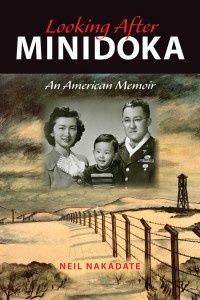Although its publisher markets Looking after Minidoka as a “memoir,” this volume can lay equal claim to being a “history.” It is, in fact, the superlative fusion of these two genres that accounts for the most fundamental value and utility of this richly documented, exquisitely composed, and diversely illustrated work. Rather than a personal memoir, Neil Nakadate (an emeritus professor of English at Iowa State University) has fashioned a family memoir that conveys to readers the historical experience of his immigrant Issei grandparents, his U.S.-born Nisei parents, and his own Sansei generation of American citizens. Moreover, he has resourcefully and strategically situated this family memoir into the context of the larger Japanese American story.
Whereas three of Nakadate’s five chapters are designated generationally as “Issei,” “Nisei,” and “Sansei,” the longest of his chapters, by a wide margin, is titled “Minidoka, 1942-1945.” He constructs this chapter on the unstated premise that the social disaster inflicted upon people of Japanese ancestry by the U.S. government during World War II was the defining moment for both his particular Nikkei family and Japanese America generally. (Notwithstanding that Neil Nakadate was born in 1943 in East Chicago, Indiana—where his father Katsumi had been undertaking his medical residency before assignment to the segregated 442nd Regimental Combat Team. The Minidoka concentration camp in Idaho functions as his foremost life history “search engine” owing to his six-month confinement there in 1944 with his mother Mary and her Marumoto family). A final short chapter, “Unfinished,” focuses upon the post-World War II redress and reparations movement. Therein he not only explores what this intergenerational and interracial movement signified for different people within both his ethno-racial family/community and mainstream America, but also ruminates as to what it might possibly come to mean “going forward, to the vast majority of (all) Americans” (p. 197).
Looking after Minidoka breaks little in the way of new ground for those who have extensively researched the Japanese American experience and/or lived through a protracted stretch of it. However, in the process of making better sense for himself of this experience, Nakadate has consulted, comprehended, and conveyed the essential core of secondary literature bearing upon it. Moreover, he has illuminated his research findings in so strikingly engaging a manner as to render his book both an ideal informational platform relative to Japanese American history, society, and culture and a powerful springboard for further inquiry into this noteworthy sphere of knowledge.
This remarkable book is highly recommended reading for (younger) Sansei, Yonsei, Gosei, and members of the burgeoning hapa population, as well of those of whatever background, in and out of educational institutions, who seek enrichment as individuals and communal beings within a multicultural nation via greater awareness of the Nikkei experience in the United States.
My only reservation about Looking after Minidoka is the very modest one that it lacks an index, which unfortunately seems to be standard practice these days for published memoirs.
* * *
LOOKING AFTER MINIDOKA: AN AMERICAN MEMOIR
By Neil Nakadate
(Bloomington, Ind.: Indiana University Press, 2013, 236 pp., $20, paperback)
*This article was originally published on Nichi Bei Weekly, on January 1, 2014.
© 2014 Arthur A. Hansen / Nichi Bei Weekly








